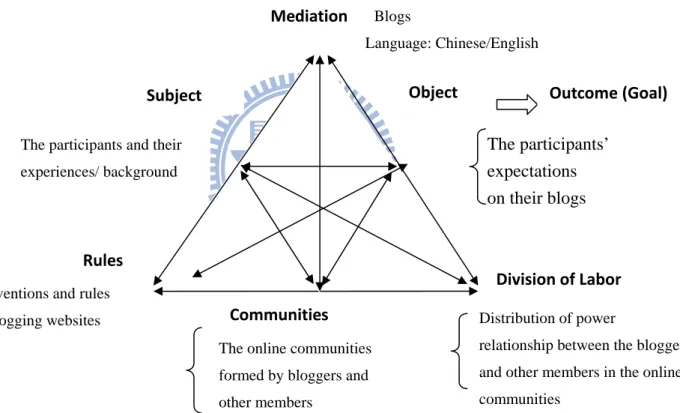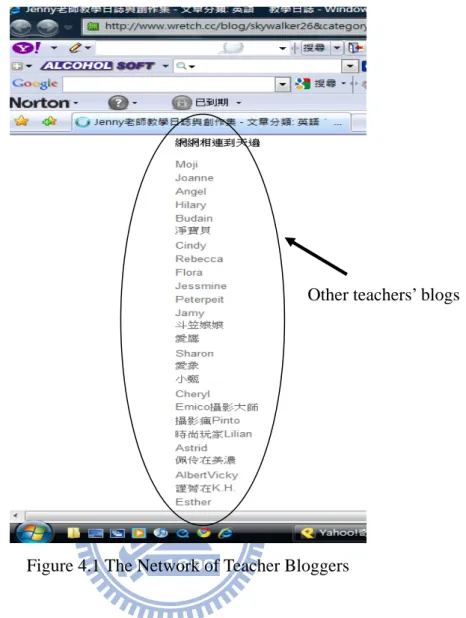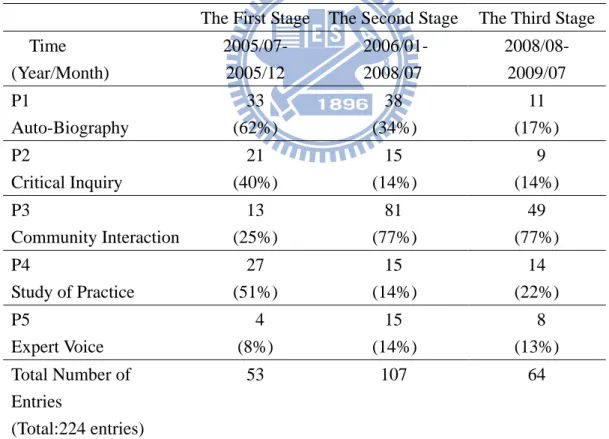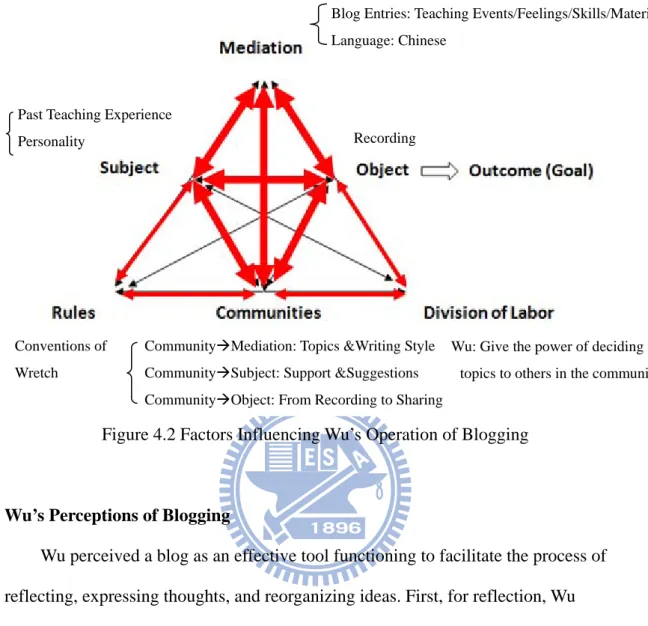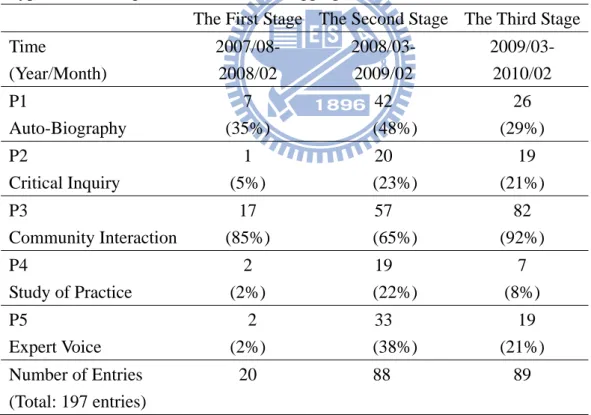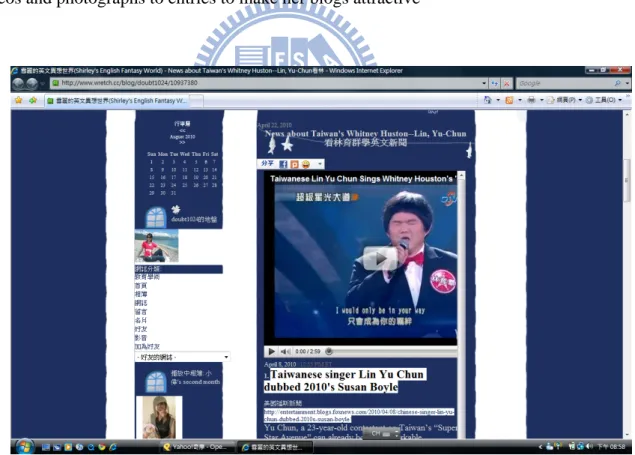部落格為中介行為之教師發展
全文
(2) . 論文名稱:部落格為中介行為之教師發展 校所組別:交通大學英語教學研究所 畢業時間:九十八學年度第二學期 指導教授:張靜芬博士 研究生:劉宜汶 中文摘要. 教師發展之研究已由強調教師對課程內容的知識轉為注重教師個人經驗和實 際教學中之社會因素(如師生關係,學校社群)。近年來,隨著社交網絡的廣泛 使用,最受歡迎的社交網絡工具之一 -- 部落格,廣被第二語言教師使用於教學 紀錄與意見交流(Ferdig, 2007)。雖然探索教師部落格的研究逐漸增加,鮮少研究 嘗試由社會文化角度檢視此項議題。 本研究針對兩位英文老師,吳與林,探討他們的部落格行為和教師發展間的 關係。研究問題有三個,包括: (1)什麼因素影響這兩位教師部落格過程中的行 為,(2)部落格如何促進兩名教師的教師發展,以及(3)這兩位老師如何看待 他們的部落格經驗。研究資料由參與者的部落格文章,訪談與線上觀察中取得, 其部落格文章依據六項具實證基礎的教師學習實踐方式編碼(一:自傳、二:批 判探索、三:社群互動、四:教學實踐學習、五:專家之聲、六:長期參與專業 工作)。這六個方式為 Darling-Hammond 和 Hammerness (2005) 所提出,並於其後 由 Luehmann(2008)架構,以探索教師透過部落格學習並發展的有效方式。而根據 分析人類行為複雜性的框架,活動理論(Engestrom, 1987, 1999) ,訪談和線上觀 察資料將藉由歸類出個人活動系統下的因素進行分析,即「個體」 、 「欲達成之目 標」 、 「達成目標之媒介」 、 「個體存在之社群」 、 「社群內之規則」 、 「以及個體與他 人間的權力關係」。 研究結果指出,即使有著不同的個人背景和經驗,吳與林在個人與人際方面 都受益於部落格行為。一方面,紀錄之餘,書寫過程亦提供兩位教師表露情感的 i .
(3) . 機會,增強了個人的反思。另一方面,撰寫部落格過程中,吳與林都張貼大量社 群互動相關文章,兩名教師也表示網路社群特別在提供支持和建議部分扮演重要 角色。此外,吳與林都認為部落格是個有助於他們教師發展的工具,並對該經驗 持正面的態度。 本研究顯示,部落格為一對觀察教師複雜省思行為具有高度潛力的工具。此 外,溝通以及與其他人在網絡社區的連結有助教師更新思路,同時協助他們不斷 提升自我。因此,對教師教育而言,應用部落格優勢於教師發展是一個很可能的 新方向。對於教育應用的建議,本研究建議教師培訓機構與學校應嘗試邀請教師 創立自己的部落格,同時支持教師間的連結以建立教師網路社群。. 關鍵字:社會文化理論、活動理論、教師發展、部落格. ii .
(4) . ABSTRACT Research on teacher development has undergone a shift from an emphasis on teachers’ content knowledge to attention to teachers’ personal experience and social factors situated in their teaching practice (e.g. student-teacher relationship, school communities). In recent years, with the widespread use of social networking, blogs, one of the most popular social networking applications has been popular for L2 teachers to record their teaching and exchange ideas with other teachers (Ferdig, 2007). While an increasing amount of research has explored teacher blogs, little has been done to examine this issue from sociocultural aspects. This study targets two English teachers, Wu and Lin, and investigates the relationship between their blogging and teacher development. Three research questions are addressed, including (1) what factors affect the two teachers’ operations in the blogging process, (2) how blogging may mediate the two teachers’ development, and (3) how the two teachers perceive the blogging experiences. Data are collected from the participants’ blog entries, interviews, and online observations. The blog entries are coded according to the six empirically grounded learning practices, Auto-Biography (P1), Critical Inquiry (P2), Community Interaction (P3), Study of Practice (P4), Expert Voice (P5), Long-Term Engagement in Professional Work (P6). The six practices were recognized by Darling-Hammond and Hammerness (2005) and later framed by Luehmann (2008) to explore the practices which are effective for teacher learning and development through blogging. Drawing on Activity theory (Engestrom, 1987, 1999), which is an analytical framework to map out the complexity of human behaviors, interviews and online observation data are analyzed by sorting out the factors underlying individuals’ activity systems, namely individuals’ agency, goals to be achieved, mediated artifacts to achieve the goals, the communities where. iii .
(5) . individuals are situated, rules embedded in communities, and the relationship between individuals and others. Findings of this study reveal that, while with different personal background and experiences, Wu and Lin both benefited from blogging not only intrapersonally but also interpersonally. On the one hand, in addition to recording, the process of writing offered the two teachers an opportunity to express feelings and enhanced their personal reflection. On the other hand, during the blogging process, Wu and Lin posted a large amount of entries related to community interaction. The two teachers reported that the online community especially played a significant role in providing support and suggestions. Moreover, Wu and Lin both perceive blogs functioning as a beneficial tool for their development and hold a positive attitude toward the experiences. The present study indicates that a blog is a high potential tool to observe the complicated reflecting process of teachers. Additionally, communication as well as connection with others in the online community are helpful to refresh teachers’ thoughts and assist them to continuously improve themselves. Thus, taking the advantages of blogs in teacher development is possibly to be a new direction for teacher education. For pedagogical implications, it is suggested that teacher training programs and school should not only try to invite teachers to launch their own blogs but also support links among teachers to build online teacher communities.. Keywords: sociocultural theory, activity theory, teacher development, blogs. iv .
(6) . ACKNOWLEDGEMENTS. I would like to thank those who have helped me during the process of completing this master thesis. First and foremost, I would like to express my heartfelt gratitude to my advisor, Dr. Chin-Fen Chang, who is a considerate and respectful mentor for me. I most appreciate her continuous encouragement and advice. She was extremely patient to read the drafts my thesis and offer insightful comments. Without her stimulation and inspiration, my thesis could not be completed.. My sincere gratitude also goes to my committee members, Dr. Chi-Hua Kuo and Dr, Shiou-Wen Yeh. Their tremendous help and priceless suggestions contributed to improving the final product of the thesis.. My special thanks are sent to my participants. Their generous participation and sharing provided valuable data for this research. Both of them are excellent English teachers. I am glad to have them in my study.. Finally, I would like to thank my family and all of my friends for their endless encouragement and care. No matter what happened, they always stood by my side. I was so blessed with many kind people supporting me through the journey of my graduate study. For me, they are the most valued people in the world.. v .
(7) . TABLE OF CONTENTS 中文摘要…………………………………………………………………….. ABSTRACT ………………………………………………………………… ACKNOWLEDGRMENTS………………………………………………..... TABLE OF CONTENTS……………………………………………………. LIST OF TABLES…………………………………………………………… LIST OF FIGURES…………………………………………………………... i iii v vi x xi. CHAPTER ONE INTRODUCTION……………………………….................. 1. Background and Rationale…...……………………………………………….. 1. Research Questions…………………………………………………………… 5 Significance of the Study……………………………………………………... 5 CHAPTER TWO LITERATURE REVIEW…………………………………... 6. Theoretical Framework: Sociocultural Theory……………………………….. 6. A General Description……………………………………………………. 6. Mediation…………………………………………………………………. 8 Activity Theory…………………………………………………………... 9. Activity Theory and Second Language Teaching and Learning………….. 11. Teacher Development………………………………………………………… 12 Current Conceptualization of Teacher Development……………………... 12. A Conceptual Shift from Content Knowledge to Mental Functions….... 14. A Theoretical Shift from Product-Oriented to Process-Oriented………. 15. Studies on Teacher Development…………………………………………. 16. Reflective Teaching…………………………………………………...... 17. Teacher Diaries/Journals……………………………………………...... 18. Applying Teacher Journals/Dairies to Teacher Development…………. 19 Integration of Technology into Teacher Development…..…………………… 21 Technology as Mediating Artifacts for Learning…………………………. vi . 21.
(8) . Blogs: One of the Most Widely Used Tools for Teacher Development…. 23. Blogs for Personal Reflective Practice……………………………………. 25. Blogs for Online Communities Building…………………………………. 26. CHAPTER THREE METHODOLOGY…………………………………........ 29. Study Settings………………………………………………………………..... 29. The Recruitment of Participants………………………………………………. 30. Wu: A Descriptive Portfolio……………………………………………… 32 Wu’s Blog………………………………………………………………… 33 Lin: A Descriptive Portfolio………………………………………………. 36. Lin’s Blog…………………………………………………………………. 38. Data Collection………………………………………………………………... 40. Data Sources………………………………………………………………. 40. Data Collecting Procedure………………………………………………... 42. Data Analysis…………………………………………………………………. 43 Analysis of Blog Entries………………………………………………….. 43 Analysis of the Interview Data……………………………………………. 45. Data Analysis Procedure………………………………………………….. 48. Trustworthiness of Research…………………………………………………. 51. CHPATER FOUR RESULTS…………………………………………………. 52. Case One: Wu…………………………………………………………………. 52. . Motivation for Wu to Start Blogging……………………………………... 52 Wu’s Blogging Process…………………………………………………… 53 Type of Learning Practices in Wu’s Blogging Process………………….... 57. Factors Influencing Wu’s Blogging………………………………………. 58. Subject Agency and Object…………………………………………….. 58. vii .
(9) . Mediating………………………………………………………………. 61. The Interaction of the Online Community with Other Factors………... 62. Rules and Division of Labors……………………………………........... 68. A Summary of Wu’s case……………………………………………….... 69. Wu’s Perceptions of Blogging……………………………………………. 70. Case Two: Lin………………………………………………………................ 72 Motivation for Lin to Start Blogging……………………………………... 72 Lin’s Blogging Process…………………………………………………… 72 Type of Learning Practices in Lin’s Blogging Process………………….... 76. Factors Influencing Lin’s Blogging………………………………………. 77. Subject Agency and Object…………………………………………..... 77. Mediation……………………………………………………..……….. 77. The Interaction of the Online Community with Other Factors………... 80. Rules and Division of Labors…..………………………………............ 82. A Summary of Lin’s Case……………………………............................. 82. Lin’s Perceptions of Blogging…………………………………………... 83. CHAPTER FIVE DISCUSSION AND CONCLUSION…………………….. 87. . Discussion of the Research Questions……………………………………….. 87. How Are the Targeted English Teachers’ Blogging Influenced by the Factors Situated in Their Blogging Process?............................................... 87 A Comparison of the Type of Learning Practices between Wu’s and Lin’s Blogging Process..……………………………………………….. 87. Factors Influencing Wu’s and Lin’s Blogging Process………………... 89. The Similarities of Wu’s and Lin’s Blogging Process…………………. 89. The Differences between Wu’s and Lin’s Blogging Process…………... 92. How May Blogs Mediate the Target English Teachers’ Teacher Development?.............................................................................................. .. 94. viii .
(10) . Blogs as an Intrapersonal Tool…………………………………………. 95. Blogs as an Interpersonal Tool…………………………………………. 97. How Do the Targeted English Teachers Perceive the Blogging Experiences in Their Development?............................................................ 99. Conclusion…………………………………………………………………….. 100. Pedagogical Implications……………………………………………………... 103 Limitations of the Study………………………………………………………. 104. Recommendations for Future Research………………………………………. 104. REFERENCES…………………………………………………………………. 106. APPENDICES…………………………………………………………………. 111. Appendix A Consent Form …………….…………………………………….. 111 Appendix B Interview Guides………………………………………………... 112. Appendix C Operational Definition of Teacher Learning Practices with Examples…………………………………………………………………….. 115. . ix .
(11) . LIST OF TABLES Table 3.1 The Participants’ Demographic Information…………………………… 32 Table 3.2 Data Collecting Procedure…………………………………………….... 43. Table 3.3 The Arrangement of the Participants’ Blog Entries for Analysis………. 49. Table 4.1 Categories and Frequency of Entries in Wu’s Blog…………………….. 53. Table 4.2 Types of Learning Practices in Wu’s Blogging Process……………….... 57. Table 4.3 Categories and Frequency of Entries in Lin’s Blog…………………….. 74. Table 4.4 Types of Learning Practices in Wu’s Blogging Process………………... 76. Table 5.1 Type of Learning Practices in Wu’s and Lin’s Blogging Process…….... 88. x .
(12) . LIST OF FIGURES Figure 2.1 The Expanded Activity System……………………………………... 10. Figure 3.1 The Interface of Blogs in Wretch..………………………................... 30. Figure 3.2 Wu’s Blog: The Homepage………………………………………….. 34. Figure 3.3 Wu’s Blog: Entries Related to Teaching…………………………….. 34. Figure 3.4 Wu’s Blog: Wu’s Classification of Entries…………………………... 35. Figure 3.5 Lin’s Blog: The Homepage and Entries Related to Teaching………... 38. Figure 3.6 Lin’s Blog: Lin’s Classification of Entries…………………………... 39. Figure 3.7 The Expanded Activity System………………………………………. 48. Figure 4.1 The Network of Teacher Bloggers…………………………………… 56 Figure 4.2 Factors Influencing Wu’s Operation of Blogging……………………. 70 Figure 4.3 An Example of Videos in Lin’s Blog…………………………………. 79. Figure 4.4 Factors Influencing Lin’s Operation of Blogging……………………. 83 Figure 5.1 The Similarities of Wu’s and Lin’s Blogging Process………………... 90. Figure 5.2 The Differences between Wu’s and Lin’s Blogging Process………… 92. . xi .
(13) . CHAPTER ONE INTRODUCTION Background and Rationale “Development is a strategy of influence and indirect intervention that works on complex, integrated aspects of teaching; these aspects are idiosyncratic and individual” (Freeman, 1989, p. 276). Teacher development is a continuing process involving change and maturity in multiple dimensions including intellectual, experiential and attitudinal (Freeman 1989). Through increasing or shifting awareness, it assists teachers to generate changes of beliefs or behaviors during their teaching process, providing a longer-term goal and facilitating their growth. Development is essential for teachers because it not only helps them gain knowledge and skills of the subject matter but also enhances their ability to cope with difficulties during the teaching process (Richard, 2005). In the field of second language teaching and learning, research focus of teacher development has undergone a shift from an emphasis on teachers’ content knowledge to teachers’ personal experience and social factors situated in their teaching practice (e.g. student-teacher relationship, school communities). As Johnson (2006) indicates: Although the overall mission of second language (L2) teacher education has remained relatively constant, that is, to prepare L2 teachers to do the work of this profession, the field’s understanding of that work—of who teaches English, who learns English and why, of the sociopolitical and socioeconomic contexts in which English is taught, and of the varieties of English that are being taught and used around the world—has changed dramatically over the past 40 years. (p. 237) In other words, while the ultimate goal of teacher education is still to make teachers able to do the job, the understanding of how L2 teachers learn to teach has been shifted toward a more sociocultural perspective. Johnson (2006) proposes the term “sociocultural turn” to describe the application of sociocultural theory to study 1 .
(14) . teacher development. The term infers human learning as “a dynamic social activity which is situated in physical and social contexts, and is distributed across persons, tools, and activities” (p.237). More specifically, the notion of “sociolcultural turn” suggests that human beings develop as participants in cultural communities and only an understanding of the cultural practice and circumstances in their communities can reach an exhaustive interpretation of their developmental process (Rogoff, 2003). With the introduction of sociocultural theory to teacher development, teachers are no longer regarded as flat characters but as individuals with different experiences, beliefs and expectations (Chen, 1997). Moreover, in addition to skill training, the influence of socio-historical factors on the individuals’ mental functions and decision making during the teaching process has become a core of research and practice in this field. Sociocultural theory is a concept consisting of manifold aspects and one of the basic notions is “mediation.” Mediation refers to a process involving sociocultural and historical tools to shape human action. In sociocultural perspectives, human learning is mediated and human beings only interact with the world indirectly through mediating tools including language, words, or other visible/invisible materials (Lantolf, 2000; Lei, 2008; Vygotsky, 1978, 1987). The idea of mediation is later developed into Activity Theory, a theory which seeks to explore human behaviors by analyzing the relationship between individuals and the social-historical contexts, explaining the process of human development in a more comprehensive and systematic way (Leont’ev, 1978). In Activity Theory, a person’s framework for thinking is closely related to historical, culturally-grounded actions and human behaviors are considered as activities intertwined with many contextual factors which work together, constantly leading to different outcomes (Engeström, 1987, 1999; Vygotsky, 1986). Activity Theory has been applied to studying teacher behaviors in recent years (Jonassen & Rohrer-Murph, 1999). After providing an explicit and 2 .
(15) . thorough description and analysis of Activity Theory, Jonassen and Rohrer-Murph (1999) claimed that Activity Theory, which functions as social-cultrual lens, has the potential to assist designers to analyze human activity systems and suggest different perspectives for analyzing learning process and outcomes for the purpose of designing instruction for teacher learning. Sociocultural Theory not only brings a shift in research focus but also leads to increasing attention to more personal approaches for teacher development which emphasize on observing individuals’ inner feelings and thoughts. Reflective teaching, for instance, has been suggested as a useful approach to help teachers reflect their in-class behaviors among the research of teacher development. As Bartlett (1990) notes, improvement of teaching must be achieved through reflection, which is both a process focusing on the daily classroom teaching and an action oriented as well as historically-imbedded social frame relating the individuals with a situation. Reflection appears as a response including teachers’ conscious recall as well as examination of previous experiences and then serves as a basis for evaluation, decision making, planning and action. Previous research has proposed that journal/diary writing is one of the effective ways of doing reflection (Richards, 1991). Through diaries, the operating process of human inner mental functions can be clearly observed. Recently the use of dairy writing has been extended to the field of teacher development. Involving observations, feelings, reactions, interpretations, reflections, hunches, hypotheses and explanations together which form a mean with high potential to interpret the teaching process, diary writing is suggested as a valuable routine leading into a number of areas of professional development and meta exploration, ending up with fresh perspectives (McDonough, 1994). Blogs, one of the most popular forms of electronic diaries, have gradually 3 .
(16) . become a popular way for people to record daily life and exchange messages. Different from traditional ways of reflective practice, teachers may record electronic blog entries and do asynchronous sharing through the Internet. Being a collection of multi-media narratives and web links, blogs function as a creative outlet for people to interact with one another as well as exchange ideas (Lin & Yuan, 2006). The growing number of teacher blogs has also drawn much attention in teacher development. However, first, many of the studies examining teacher blogs center on short-term teacher training programs; not until very recently, studies concerning with more longitudinal blogging process have been conducted (Chan & Ridway, 2005; Jarvis, 1992; Luehmann, 2007; Numrich,1996). Second, former research on teacher diaries or teacher blogs usually depends on concordance analysis to examine the frequency of words and trace the variance of frequency over time instead of specifically examining the contents of the entries (e.g. Jeffrey, 2004, 2007; Jeffrey & Hadley, 2002). Third, although a few recent efforts have started to study teacher blogs in Taiwan, these studies neither aimed at language teachers nor intended to explore teacher blogs in a qualitative way. In addition, among the studies trying to address the relationship between blogging and teacher development, few of them attempt to examine the issue through sociocultural perspectives. Reviewing literature concerned with present computer mediated communication(CMC) tools, Ferdig (2007) summarized the advantages of using these tools including encouraging active participation, providing a constructive learning environment which promotes feedback and reflection, making learning occur through central participation of the community and building an environment supporting scaffolding. These advantages all correspond to the key concept of sociocultural theory which suggests that learning is a process of participation. Thus, applying sociocultural perspectives to examining blogging and teacher development may contribute to a more extensive and complete 4 .
(17) . understanding of the interaction between teachers and the contextual factors during the blogging process.. Research Questions The current study adopts sociocultural theory as a theoretical basis, in particular taking the teachers’ experiences and social-historical contexts into consideration to investigate how blogging process may mediate second language teachers’ development. Three research questions are addressed: 1.. How are the targeted English teachers’ blogging influenced by the contextual factors situated in their blogging process?. 2.. How may blogs mediate the targeted English teachers’ teacher development?. 3.. How do the targeted English teachers perceive the blogging experiences in their development?. Significance of the Study Through the lens of sociocultural theory, the present study intends to investigate the potential of blogging as a tool for enhancing teacher development. It is hoped that addressing these questions will contribute to a more comprehensive understanding of teacher development through blogging and seek for the possibilities of using blogging to teacher education. After a concise introduction of the background and rationale of the present research, in the next chapter, related literature will be reviewed.. 5 .
(18) . CHAPTER TWO LITERATURE REVIEW This chapter first provides a brief review of sociocultural theory and related concepts including mediation and Activity Theory. Then, I will discuss literature concerned with teacher development as well as the integration of technology into teacher development.. Theoretical Framework: Sociocultural Theory. A General Description Developed by the Russian psychologist Vygotsky (1987) and his colleagues, sociocultural theory is initially applied to explain the process of human development, aiming to understand how people organize and use their minds for carrying out the business of living. The fundamental tenet of the theory holds that sociocultural and mental activities are bound together in a dependent and symbolically mediated relationship (Lantolf & Pavlenko, 1995). Drawing on the tenet, the individual and the social are necessarily relational and social origins take on special importance in sociocultural theory (Lantolf, 2000). According to Vygotsky, the notion of sociocultural theory can be examined particularly in the developmental process of children. To have a complete understanding of a child’s developmental process, the social environment which the child lives in must be explored since learning is embedded in the activities as the child interact with objects, events, and people in the social environment (Vygotsky, 1986). Such a social process is the precursor and gives rise to the individual process. While both are essentially mediated by artifacts, sociocultural theory proposes that the interpersonal (inter-mental) processes are the necessary condition for the emergence 6 .
(19) . of individual (intra-mental) processes (Cole & Wertsch, 2002). Generally speaking, Vygotsky’s sociocultual theory can be capsuled in terms of three major principles. First, only a thorough analysis of human mental process can achieve a complete and accurate interpretation of human mental functioning. Second, all higher mental functions have social origins. In other words, those mental functions all originate in social activities. Third, sign systems play a significant role in distinguishing cultural forms from communicative forms of human behaviors and the decontextualization of meanings of words constitutes a prerequisite for the transition from the interpersonal to intrapersonal level (Johnson, 2004). Simply stated, Vygotskian sociocultural theory describes the dialectic interactions between the external (social) and internal (mental) process. In the theory, there is a connection between language and thoughts. The connection originates from interpersonal level, and then is mediated by semiotic sign systems and internalized within individuals. Sociocultural theory is closely related to human mental development. To examine human mental functions, Vygotsky (1978, 1986) suggests higher forms of mental activities including voluntary attention, logical memory, rational thoughts, and the planning, execution, and monitoring of mental process as the proper unit of study. Each of the activities can be fully understood only when observed either in its formation over time or when it is disturbed. By specifically discriminating and analyzing those metal activities, sociocultural theory is appropriate lens for analyzing human learning as a developmental process. Recently, the theory has been applied to language education and literature has indicated that it provides different understandings and recommendations for improving language teaching and learning (Zuengler & Elizabeth, 2006). It should be noted that sociocultural theory is not a single theory. Thus, the following parts will contribute to a review of two concepts within the theory which are related to the present research including mediation and 7 .
(20) . Activity Theory.. Mediation Mediation is one of the most distinguishing concepts of sociocultural theory. Vygotskyan sociocultural theory argues that human mental functioning is basically a process intertwined by cultural artifacts, activities, and concepts. During the process, the function of mediation is essential. In other words, human behaviors are activities consisting of and affected by sociocultural factors and mediating artifacts serve to connect the individuals (subject) and the goals (object) they would like to achieve. Mediation is an active process involving the potential of cultural tools and the unique use of such tools to shape human action. According to Vygotsky, human mind is comprised of a lower-level neurobiological base with the distinctive dimension of human consciousness to control over biology either through the use of higher-level mediating technique tools (e.g. a saw) or through psychological tools/signs (e.g. language). Human beings can, possibly, control their behavior from the outside by means of tools and regulate their minds from the inside by means of signs. Mediation exactly refers to indirect connections linking the individual and the social-material world with the assistance of mediating tools or signs (Lantolf, 2000; Lei, 2008 ; Vygotsky, 1978, 1987). An underlying assumption of mediation is that all higher forms of human mental activity are mediated. That is, human beings access to the world only indirectly (mediately), through the mediation of artifacts, rather than directly (immediately). Those activities arise while individuals interact with other members, with the culture, with specific experiences or with other artifacts. Moreover, the interaction is a dialectic relationship between human, society and culture. Namely, not only individuals’ mental activities determine the nature of our social world but also the 8 .
(21) . world of human relationships and artifacts determine how we regulate our mental process (Lantolf, 1995, 2000, 2005).. Activity Theory Leont’ev (1978) later develops Vygotsky’s ideas of social and cultural mediation by developing a hierarchical model of human activity, Activity Theory. Sociocultural theory suggests that human learning is basically a situated and mediated process intertwined by the individual mind and social milieu (Lantolf, 2000). Among the multitudinous concepts in sociocultural theory, Activity Theory is a key theory seeking to explain social and cultural practices by relating them to the cultural and historical contexts. It is not a methodology but “a philosophical framework for studying human beings with the developmental processes in which both individual and social levels interlinked at the same time” (Jonassen, 1999). In other words, Activity Theory tries to illustrate and interpret human behaviors by examining the dialectic relationship between individuals and the social contexts. Activity Theory is originally used to explain individual activities and thus the basic unit of analysis held by the theory is an “activity.” According to Activity Theory, human activities are driven by needs in order to achieve certain purposes. Leontiev (1978) proposed that an activity comprises three levels, the activity level, the action level and the operation level. Activities consist of series of actions, which consist of operations. Actions are basic components of activities guided by goals; operations are executing actions which correspond to goal achievement (Lantolf, 2000; Leontiev, 1978). However, the line between an action and an activity is difficult to define as goals and motives often overlap each other and are used interchangeably. As a result, all the three levels can possibly move both up and down as the needs arise (Marra, 2005). 9 .
(22) . Engeström (1987, 1999) extends the basic assumptions of Activity Theory and developed a systematic model named “activity systems” as shown in Figure 2.1. Engeström’s model intends to explain collective activities and cooperative work in term of the interaction between an individual and his/her environment through mapping out essential elements in an activity, namely, the objects set by individual agency, the mediated artifacts, the community and its rules, and finally the division of labor. In the model, an activity is undertaken by a human agent (subject) who is motivated toward the targeted point (object), and mediated by different artifacts, tangible and intangible alike (artifacts), in collaboration with others and ultimately reach the desired outcome. In addition, the structure of the activity is shaped and constrained by other sociocultural factors including conventions or regulations (rules), interaction with others who share the same object (community) and social divisions, which refers to power status divided among members of that community (division of labor) within the context (Engeström, 1987, 1999).. Figure 2.1 The Expanded Activity System (Engeström, 1987, 1999) The model of activity systems depicts the interaction between individuals and activities specifically. In activity systems, it is crucial to realize that what helps to. 10 .
(23) . analyze human mental function is not the individual elements of the system but the relationships between these elements which are operations and actions occurring in and across time periods, forming the unit of analysis and support transformation (Lantolf & Thorne, 2006). The interplay between the various elements continuously leads to various new outcomes. Consequently, all elements of this system are not fixed but are constantly changing. More importantly, the model emphasizes on the activities in which people are engaged, the nature of the tools applied, and the social as well as contextual relationship.. Activity Theory and Second Language Teaching and Learning Over the last few decades the research focus of the Activity Theory has moved from psychology to social contexts and to education as well. From a sociocultural perspective, learning is participation and is a relational as well as interactive process. In the field of language teaching and learning, the influence of context on teaching and learning has gradually gained attention and Activity Theory in recent years is adopted as an explanatory tool to address the complexity of the operating process of students and teachers as well (Chang, Lin, Lee & Liu, 2009; Coughlan & Duff,1994; Lantolf, 2002). It is, apart from being a tool to examine students’ learning process; Activity Theory is also useful lens to investigate teacher learning and development (e.g. Chen, 1997; Jonassen & Rohrer-Murph, 1999). From the perspective of Activity Theory, individual thoughts are closely related to historical, culturally-grounded actions as well as the social contexts and thus the theory is effective for understanding the process of learning to teach. After examining the nature and elements of Activity Theory, Jonassen and Rohrer-Murph (1999) consider the theory as social-cultural and social-historical lens with the potential to analyze human activity systems and provide different prospects for analyzing learning 11 .
(24) . process and outcomes for the purpose of designing instruction. A later study elaborated key concepts of Activity Theory and also claimed that the theory is useful for studying the conceptual change and professional development of teachers (National Research Center on English Learning and Achievement, 1999). In addition, previous research on teacher learning has reported the close connection between the writing process of reflective writing, which is a beneficial tool to enhance teacher learning, and activity systems (Wells, 2002). It is suggested that the process of writing is compatible with the activity systems especially when the writer has to accommodate as well as communicate with external constrains or materials that may provide assistance and motivate the writer with a larger contextual purpose. In addition, there are usually a wide variety of meditational means including model texts, source of ideas and the dialogue which was usually with the self during the writing process. In this way, activity systems seem to be an appropriate framework to study teachers’ developmental process through reflective writing.. Teacher Development. Current Conceptualization of Teacher Development Within the scope of teacher education, two broad kinds of goals are often identified, training and development. Different from training, which usually directly focuses on a teacher’s present responsibilities, aiming at short-term and immediate goals, development usually serves a longer-term goal, seeking to facilitate growth of teachers’ teaching and self identification. Teacher development is a continuing process involving change and growth in dimensions of intellectual, experiential and attitudinal of teachers (Lange, 1990). Bailey, Curtis and David (2001) provided various reasons for teachers to pursue 12 .
(25) . professional development ranging from increasing income as well as gaining prestige to acquiring new knowledge and skills which may help teachers to cope with problem and make their teaching more interesting. Bailey further suggested that professional development could fulfill the goals of empowerment and enlightenment, avoiding deskilling of teaching and fighting against the negative effect of teaching. Therefore, pursuing continuous development seems essential and significant for teachers throughout their career. Hargreaves and Fullan (1992) have observed that there are three approaches to teacher development. The first one is concerned with knowledge and skill development which aims to assist teachers to develop knowledge about the subject matter and teaching strategies. The second one regards teacher development as ecological change and put emphasis on the influence of teachers’ working environment. Finally, the third approach takes teacher development as a process of enhancing self understanding of personal and practical knowledge of teaching. Responding to Hargreaves and Fullan’s ideas, Tsui, Wu and Sengupta (1996) reviewed previous literature and proposed three important basic facets of teacher development, namely the development of knowledge and skills, and the development of the teacher as a person and the development of a collaborative culture. Teacher development is a complicated concept so that traditionally there is no consensus on what teacher development encompass. Simply stated, teacher development is a concept including complex aspects which are idiosyncratic as well as individual, and the goal of development is to assist teachers generate change through the teaching process (Chen, 1997; Freeman, 1989). During the past decade a, considerable body of literature has emerged on the continuous development of teachers. Nevertheless, compared with other aspects within teacher education, it is an aspect has not yet been much explored. (Garet, 13 .
(26) . Porter, Desimone, Birman, & Yoon, 2001) In recent years, the essential themes in the field of teacher development have undergone a significantly shift due to the influence of teacher education and general educational theory. The following will be devoted to a discussion on the shift.. A Conceptual Shift from Content Knowledge to Mental Functions To study teacher development, it is essential to explore the relationship among the three terms, teacher development, teacher education, and teacher learning. Simply stated, approaches to teacher development are connected with the concepts of teacher education and the rationale of teacher education derives from assumptions in the field of teacher learning. According to Richard (2005), teacher learning is considered as skill learning, as a cognitive process, as personal construction and as reflective practice; each of the conceptualizations can lead to different approaches to teacher development. Johnson (2006) reports that the notion of teacher education has changed over the past decades and it significantly affects the research and practice of teacher development. In the mid-1970s, research on teacher education focused on teaching behaviors, ensuring that teachers mastered the content they were expected to teach and were able to deliver it through efficient methods. In the mid-1980s, due to cognitive learning theories and information-processing models, the research focus of teacher learning has shifted from content knowledge and teaching skills to the process and the impact of teachers’ decision making. From then on, the complexities of teachers’ mental lives become a major concern of teacher educators. The teachers’ prior experiences as well as their interpretations of the activities they engage in combine and both interact with the contexts, shaping the teachers’ decision making and development. In simple terms, it seems the study of teacher education has turned 14 .
(27) . toward more sociocultural perspectives.. A Theoretical Shift from Product-Oriented to Process-Oriented In addition to the shift of the field’s understanding of teacher education, previous literature indicates that traditional language teacher education housed in departments of applied linguistics, education, or languages and literature was fragmented and overlooked teaching itself (Freeman, 1989). During the last decade general educational theory and practice have exerted a more powerful influence on the direction of teacher education. Derived from the theory and practice of general education, there are shifts of focuses in language teacher education including a move from product-oriented theories to process-oriented theories of teacher learning, an emphasis on situated teacher practice and the development of concrete linkages between theory and practice, a growing recognition of the powerful role teachers’ prior learning experiences played in shaping teachers’ views of teaching and a growing concern that teacher development should be handled through sustained research and in-service programs rather than the typical short-term or one-shot training programs (Crandall, 2000). To summarize, in addition to the facet mentioned in previous literature such as teaching skills and working environment, recent studies tend to emphasize more on situated and socialcultural views of teacher behaviors. Teachers’ personal development has become another essential dimension worth examining (Tsui, Wu & Sengupta, 1996). Knight (2002) further insists that teaching ability and enjoyment of teaching is as much about how teachers feel about themselves as it is about how many slick teaching techniques they can string together. Thus, it is important for oneself to develop a sense as a good teacher. In other words, nowadays research on teacher development has regarded teachers as individuals, studying teachers’ individual 15 .
(28) . development as a whole instead of dividing it into fragment areas and examining each single fragment. As the new reconceptualization claimed by Freeman (1998), learning to teach is a sociocultural process and the experiences in teacher education would frame how the individuals respond to the basic sociocultural processes. Moreover, the core must focus on “the activity of teaching itself, centering on the teacher who does it, the contexts in which it is done, and the pedagogy by which it is done”(Freeman, 1998).. Studies on Teacher Development The change of focus in teacher development leads to a switch of trends in related in related research and practice. Traditionally, Bailey (2003) suggested that teacher development may be briefly divided into four aspects: individual level (e.g. self-monitoring), paired work (one to one, working with another colleague, e.g. peer coaching), group based (e.g. teacher support groups), and institutional directed (e.g. workshops). Generally speaking, these aspects include documenting different kinds of teaching practice or examining the teachers’ beliefs, values and communication or collaborating with peers. Johnson (2006) later claimed that a more self-directed, collaborative, inquiry-based learning that is closely connected to the daily activities of teachers and students is needed. For instance, teacher inquiry seminars, teacher study groups, narrative inquiry, and critical friends groups, for instance, are all designed as alternative means to foster and sustain teachers development. In addition to the approaches mentioned above, recently a more personal-directed and process-oriented approach, reflective teaching, which assists teachers to record the process and enhance reflections, has gained increasing attention (e.g. Boud, 2001; Jarvis, 1992; Jeffrey, 2002). Concerned with reflective teaching, diaries/journal writing has been suggested as an effective way to help teachers do 16 .
(29) . reflective practice. Therefore, in the next section, we will first concisely introduce basic concepts of reflective teaching; then, literature as well as empirical research on diaries/journal keeping and teacher development will be discussed.. Reflective Teaching According to Bailey (2003), reflective teaching is a main concept, a core of recent teacher development approaches. Most teachers gain a repertoire of teaching strategies and form their own teaching styles with experiences. However, there can be a danger hindering a teacher’s professional growth while a teacher’s teaching style serves as a mean of coping with routine demands of teaching. One effective way to help teachers move beyond the level of routine responses to classroom practice is reflection. Richards (1991) claimed that reflection is an activity or process in which an experience is recalled, considered as well as evaluated and the process is usually in relation to a broader purpose. It involves taking the unprocessed, raw material of experience, exploring the messy events and focusing on the thoughts and emotions that accompany them to make sense of what has occurred. Originally, reflective teaching was regarded as individual and independent, emphasizing a process reviewing a teacher’s behaviors and thoughts of classes which could be done on the teacher’s own. In the last decade, social factors have been brought into the idea of reflection and in this way the meaning of reflection turns to be twofold. In addition to personal thoughts and behaviors, reflective teaching also includes reflection of the relationship between a teacher and other members within the community the teacher belongs to. For teachers, doing reflective practice is the base of making changes and changes are necessary when people intend to improve themselves. To transfer from an unsatisfying behavior to a more satisfying behavior, holding a critical attitude is essential. Reflection has transcended the level of learning 17 .
(30) . teaching skills, forcing language teachers to appraise themselves and challenge their teaching beliefs (Bartlett, 1990). To be a reflective teacher, many different approaches can be employed ranging from observation of oneself and others, team teaching, self-report, autobiographies to exploring one’s view of teaching through journal writing. Among those approaches, journal writing has becoming widely acknowledged as a valuable tool for developing critical reflection (Richards, 1991). In more recent years, a growing number of studies are now available to shed some lights on the relation among teacher journals, reflective writing and teacher development (Boud, 2001; Hull, 2007; Jarvis, 1992; Richards, 1991; Richards, 2005; Suzuki, 2004).. Teacher Diaries/Journals Boud (2001) suggested that there are three types of reflection according to the occasions (reflection in anticipation of events, reflection in the midst of action, and reflection after events) and indicated that although the goals and procedures may vary with the variance of occasions, journal writing plays a significant role for all the three types of reflection. Being one of the introspective methods, journal writing is considered a more thorough approach for professional development of language teachers compared with other approaches such as video or audio taping (Jeffrey, 2002). To explore teacher journals, it is essential to review previous literature concerned with the definition and the nature of diaries and journals. Hull (2007) claimed diaries and journals are distinctive, arguing that journals tend to be written in the knowledge that the contents are in the public domain and that there are readers such as teacher trainers or colleagues whereas diaries are often written in the understanding that their contents will only be made public with the writer’s permission. However, despite the 18 .
(31) . difference, Hull also acknowledged the similarity of diaries and journals: they both refer to introspective writing. Indeed, previously Richards, Platt and Platt (1992) had already defined a “diary study” for research in first language and second language acquisition as a “regularly kept journal.” Consequently, the two terms obviously overlap each other and literature often uses them in free variation. Considering the similarity, in the present research, which mainly focuses on reflective writing instead of the distinction between journals and diaries, journals and diaries are regarded interchangeable and literature related to both will be examined.. Applying Teacher Journals/Dairies to Teacher Development According to Richard (2005), a teaching journal is an ongoing writing account of observations, reflections and other thoughts about teaching. It could be in forms of notebook or electronic mode and serves as a record of incidents, problems or insights occurring during lessons. Journal writing can fulfill different purposes depending on the audience. For teachers themselves, it can be a way of exploring their own beliefs and practice and clarifying their thoughts; for peers or supervisors, reading a teacher’s journal writing and providing feedback can be a way to encourage reflective inquiry, facilitating the teacher’s problem resolving. Both in language teaching and in teacher training, diary writing, or journal keeping, has been widely applied. Nevertheless, in the research field, not until the last two decades was the use of diary in teacher training and development studied and there were few diary studies available, especially studies concerned with diaries kept by experienced language teachers (Jeffery, 2002, 2008; McDough, 1994). Jarvis (1992) regarded teacher as learners and studied the diaries of in-service teachers in special training programs. The results mainly showed two findings. First, teachers did perceive the record as valuable and helpful in making sense of their course. Second, in 19 .
(32) . teacher diaries, teachers may record themes related to solving problems, seeking new teaching ideas and legitimizing own practice, which is a sense that one is on the right lines through understanding more fully why something works. A later research analyzing 26 diaries written by novice ESL (English as a Second Langue) teachers who enrolled in TESOL (Teaching English as Second Language for Foreign Learners) programs revealed the novice teachers’ early preoccupation with their own teaching behaviors, transfer and rejection of teaching skills, and the continued frustrations, suggesting teacher diaries actually could offer insight into the pressing needs of novice teachers (Numrich, 1996). Noticing how the rich reflective quality of the trainees’ journal writing raised the trainees’ awareness of teaching, allowing issues unnoticed to rise to the conscious level, Hull (2007) further conducted a research on an experienced teacher’s reflections on his teaching of two classes, one undergraduate and the other graduate. The results demonstrated that the patterns of the teacher in the graduate class diverged from those in the undergraduate class and the teacher neither aware nor especially paid attention to the difference. The findings not only corresponded to Hull’s argument that reflective writing could enhance teachers’ awareness but also suggested that while revealing the probably fast-changing patterns of an inexperienced teacher, reflection would be more likely to reveal the ingrained patterns of an experienced one. In other words, as for trainees, reflective writing is similarly developmental for experienced teachers. A series of three more recent studies on teacher diary experiences were conducted by Jeffrey (Jeffrey, 2002, 2004, 2008). Jeffrey (2002) conducted his first diary study when teaching in Japan. With diary analysis, Jeffrey found his focus gradually shifted away from initial nervousness, class atmosphere and concerned for activity sequencing to his personal feelings and reflections. Moreover, he noticed that 20 .
(33) . his approaches to teaching also changed as well. Jeffrey considered the process beneficial and did two other diary studies (Jeffery 2004, 2008). While reviewing and examining the three diary studies, Jeffery not only discovered how his syllabus had shifted over the years from predominately teacher centered to student centered but also noticed other factors including students’ proficiency and motivation. To conclude, the series of studies provide Jeffery deeper understanding of the realities of teaching, make him more realistic and let him realize his own abilities and limitations (Jeffery, 2008). To sum up, for teachers, there are four advantages of keeping teaching journals. Through journals, teachers can clearly describe problems they face, reveal the depressed emotion, clarify as well as further understand the teaching experience, and finally, continue to develop their professional skills (Bailey, 2001). Therefore, diary study has been categorized as the least structured, least controlled means of conducting research in teacher education, yet it is a real insider instrument providing insights (McDonough, 1994; Numrich, 1996).. Integration of Technology into Teacher Development. Technology as Mediating Artifacts for Learning Previous literature has indicated three general categories of mediation, social mediation, self mediation and artifact mediation (Lantolf, 2000). Social mediation refers to mediation by others through social interaction, self-mediation is considered as the mediation by oneself through private speech, and finally, artifact mediation is the mediation by cultural artifacts, either linguistic or non-linguistic. In each kind of the mediation, language plays a significant role to mediate the process. While language is a powerful cultural artifact available to human beings, it can also 21 .
(34) . comprise artifacts with non-linguistic features (Donato & McCormick, 1994). Take computer technology for example, the evolution of technology leads to the widespread use of computer mediated communication (CMC), which both enhances connection among human beings and provides new instruments for teaching and learning (e.g. Cameron, 2006; Lee, 2000; Richards, 2005; Riding, 2001; Rui Kang & Herbert, 2007) With the popularization of computer mediated communication, the term “social software” is created and has attracted much attention over the last few years. Social software is defined as software offering opportunities to give and receive feedback, supporting conversational interaction and individuals’ desire to be pulled into groups to achieve their personal goals. Tools including email, photo sharing, wikis, facebook and blogs are all considered as social software (Ferdig, 2007). Social software has been usually applied as a mediating artifact to encourage students’ collaboration in the virtual space (Cameron, 2006; Lee, 2000; Salaberry, 1996). In addition to student learning, social software also introduces innovative tools for teachers to interact with one another as well as exchange ideas, bringing in more possibilities and opportunities for teacher development (Loving, Schroeder; Riding, 2001; Richards, 2005; Rui Kang & Herbert, 2007). For instance, different from traditional ways of reflective practice, nowadays teachers may record electronic entries and do synchronic as well as asychronic sharing through the internet. In sociocultural perspectives, every kind of learning is mediated. Therefore, it is significant to investigate how the artifacts mentioned above function as mediators and help teachers to pursue development.. Blogs: One of the Most Widely Used Tools for Teacher Development It has been noted that descriptive and introspective research tools such as logs, 22 .
(35) . diaries and journals are particularly suited for investigating behavior in context while there are relatively few studies on teacher diaries compared with other studies of second language teaching and learning. However, with the development of technology, Suzuki (2004) suggested that the trend may change with the advent of the online diary, “blog.” “Blog” is the shortened form of “weblog” coined by Jorn Barger in 1997. Weblog originally referred to a web page with hyper links to websites which a websurfer found interesting. Nowadays, blogs, or weblogs are used to refer to online journals. Blogs are websites frequently updated with new post and thus one of the distinctive features of blogs is the order of the post. A blog is considered as a hierarchy of text, images, media objects and data arranged chronologically. Other four characteristics of a blog include personal editorship, hyperlinked post structure, archival features and free, public access to the content (Chan & Ridway, 2005; Ridgway, 2005). Regarded as electronic entries, there are three advantages of blogs. First, blogs offer access to an unlimited number of readers; second, blogs are not only personal but also interactive and collaborative since people can provide feedback to each other; finally, blogs offer instant publishing and is editing possible (Suzuki, 2004). Pervious literature has indicated various ways of applying blogs in education. The most common ones are posting work and reflecting by individual learners, discussing and publishing assignments by the whole class, posting suggestions or references for students by teachers and finally, serving as a further development and research tool for the professional community (Educational Technology Division, Ministry of Education, 2005). The current study focuses on the last one and intends to investigate how blogging contributes to teacher development. As for blogging and teacher development, Darling-Hammond and Bransford (2005) suggested five complementary types of teacher learning domains for new 23 .
(36) . teachers including vision, understanding, dispositions, practices, and tools. As Darling-Hammond and Bransford mentioned, New teachers learning to teach in a community that enables them to develop a vision for their practice; a set of understanding about teaching, learning, and children; dispositions about how to use this knowledge; practices that allowed them to act on their intentions and beliefs; and tools that support their efforts. (p. 385) Based on the five dimensions, Luehmann(2008) framed six practices to investigate teacher learning through blogging as the follows: 1. Awareness and consideration of personal educational autobiography (P1): The effects of the teacher’s previous knowledge and emotional reactions on their teaching practices. 2. Engagement in critical inquiry-based reflection (P2): The teacher’s personal reflection on teaching. 3. Engagement in community-based interactions (P3): The interaction with other members within the same community. 4. Studying practice in a way that is connected to, yet removed from, content-specific daily practice (P4): Describing goals or plans for teaching when the teacher is removed from daily classroom practices. 5. Consideration and integration of an expert voice (P5): Link with other professional resources; 6. Engagement in thoughtful, intentional professional practice over a long term and in sustained ways (P6): Both regular and longitudinal engagement in professional work. After conducting a study on a science teacher’s blogging process, Luehmann found the science teacher invested significant time and energy into her blogging. In addition, the teacher made use of several blog features including using her blog to tell. 24 .
(37) . stories, reflect on her practice, work through dilemmas, and solicit feedback. Results of the study indicated the potential of blogging for teacher development. Consistent with Luehmann’s study, aside from efficient information retrieval, rich content type and ideas exchange, it is suggested that blogs also provide multiple purposes both for personal and for group (Educational Technology Division, Ministry of Education, 2005). On one hand, blogs help the writer to do personal reflection, journaling and online repository; on the other hand, blogs assist community building and collaborative task. Based on these assumptions, blogs enhance both the personal reflective practice and group community building, which are two important aspects of teacher development and will be further explored in the next two sections.. Blogs for Personal Reflective Practice Concerned with reflective practice, previous literature has suggested a positive correlation between students’ learning performance and attitude of learning reflection. The correlation proved that blog service is an effective tool for recording learning attitude as well as performances and referring to others’ learning portfolios (Lin & Yuan, 2006). What is more, Tsui et al. (1996) indicated that while little attention was given to the process of teacher learning, not only students but also teachers could benefit from blogging. The research also inferred that although there is no obvious demonstration of teachers’ inner personal reactions, teacher’s awareness of the complexity of teaching and learning may be enhanced by journaling. Previous studies also research on the relationship between learners’ enthusiasm and blogging. Regarding online journaling offered a unique format which might stimulate learners’ enthusiasm and increase both the quality and quantity of learners’ output, Gary (2003) conducted a study on the blogging process of preservice teachers and reported both learners and instructors considered blogging as a unique mechanism 25 .
(38) . to enhance the development of reflectivity. Contrary to Gary’s findings, another study conducted by Chan and Ridway (2005) on preservice teacher learners’ in Macau concluded that blogging did not help much in the learners’ reflective practice. However, Chan and Ridway acknowledged that the participants were required to keep blog entries. Being unclear about what should be included, most of the participants had reported problems in writing journal weekly. Unfamiliarity with the concept of assessment for learning has been a phenomenon in Macau and may be part of the reasons influencing the learners’ use of blogs. Thus, while the study suggested cultural factors should be considered when applying blogs to teacher education, blog service was proved helpful for communication between teacher learners and their tutors. In addition to preservice teachers, Eekelen, Boshuizen and Vermunt (2005) studied experienced higher education teachers’ self regulating process adopting digital diary analysis accompanied with two semi-structured interviews and concluded that teachers’ learning process was in a non-linear way. Although the study did not find a fixed pattern of teacher learning, the result suggested that reading electronic diary scould be an effective way to examine teachers’ learning process. Therefore, blogging seems to enhance development for both preservice teachers and inservice teachers.. Blogs for Online Communities Building Except reflectivity, blogging is also considered as a tool for enhancing links among its users. As for teacher development, collaboration with other teachers is as important as individual work and thus gradually teacher support groups are built as a way for teachers to seek for accompany and sharing. Instead of a staff meeting, a teacher support group is a voluntary activity which involves a group of teachers meeting to discuss goals, concerns, problems and experiences. With the evolution of 26 .
數據
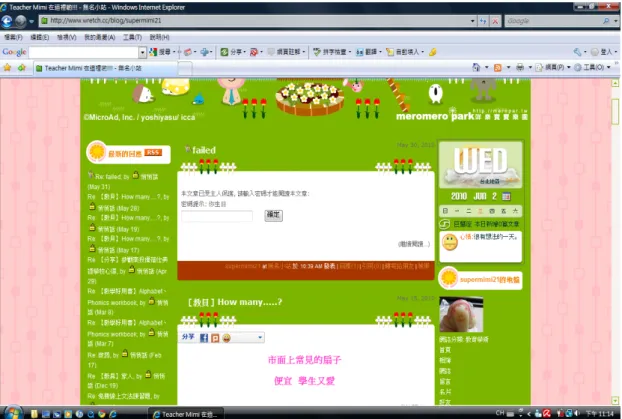
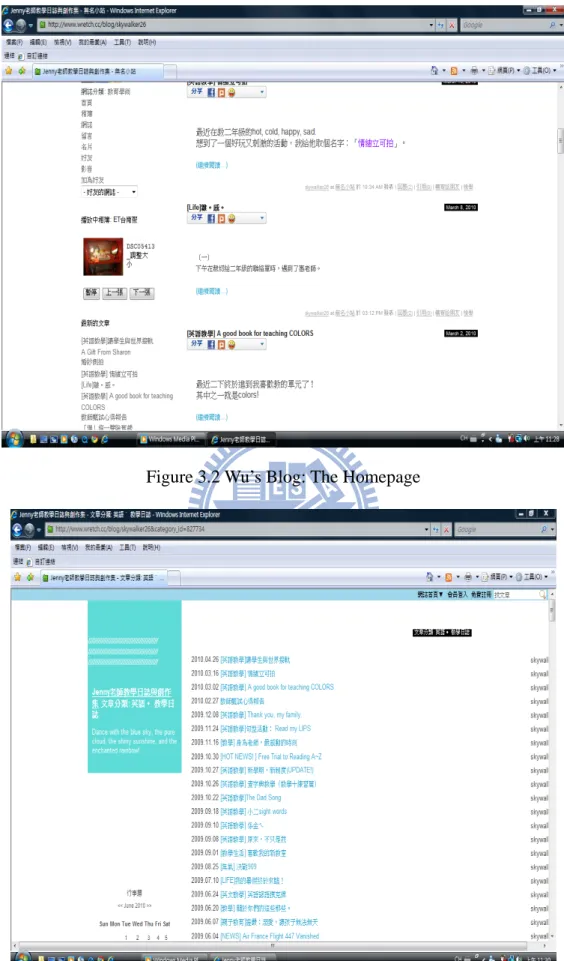
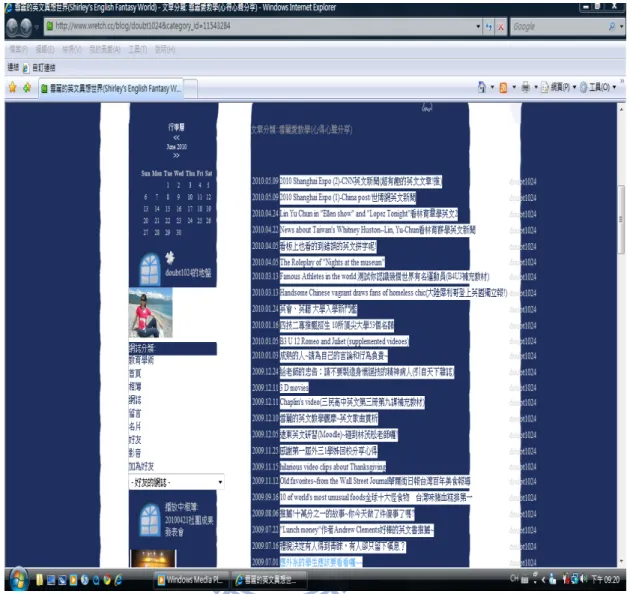
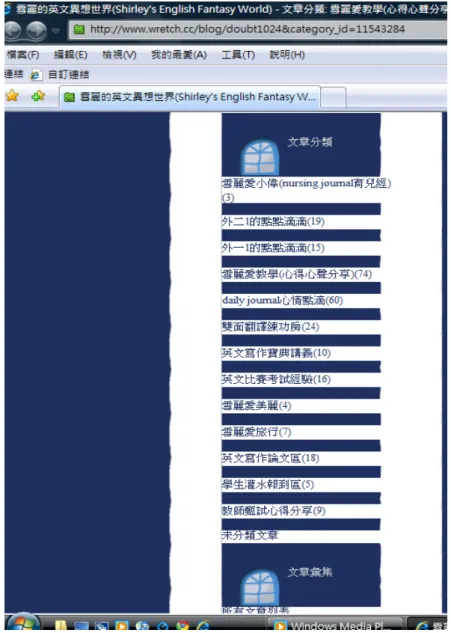
相關文件
To support schools in environmental education, we will continue to provide a broad range of services including school visits, teacher education programmes, territory-wide
1.5 In addition, EMB organised a total of 58 forums and briefings (45 on COS and 13 on special education) to explain the proposals in detail and to collect feedback from
Botswana general certificate of secondary education teaching syllabus: Food and nutrition. Retrieved June 26, 2006
Stone carvings from the Northern Song dynasty were mostly religion-oriented (namely Buddhism or Taoism), and today much of the research conducted on them has been derived from
(Keywords: general education, learning passport, language skills, cultivation in humanity, activities of music and arts, democracy and constitutionalism, the silky way over
• Hong Kong Education City originated from a Quality Education Fund project in 2000 and developed into wholly-owned limited incorporated company of the Government of the HKSAR
On top of the overall students’ attainment rates of a school in Chinese Language, English Language and Mathematics (starting from 2014, individual primary schools are no
- - A module (about 20 lessons) co- designed by English and Science teachers with EDB support.. - a water project (published
